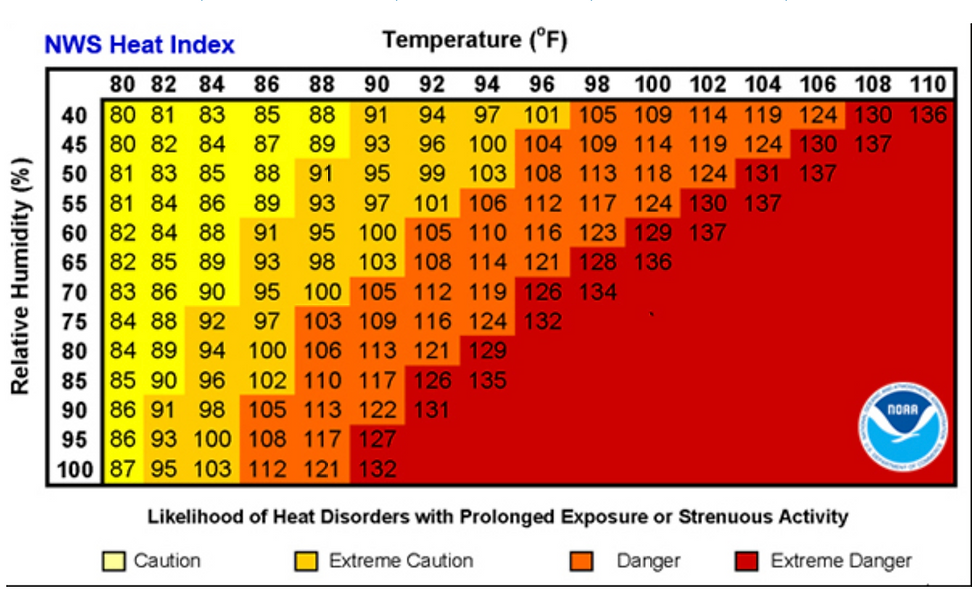Beat the Heat: Understanding the Heat Index for Safe Summer Athletics
- Olivia Ellison
- Jun 21
- 3 min read
Summer is synonymous with sun, fun, and for many, intense athletic training. But as temperatures rise, so does a critical concern for athletes, coaches, and school administrators: heat-related illness. It's not just about how hot the air feels; it's about the heat index, a crucial measurement that can make the difference between a productive practice and a dangerous situation.

So, what exactly is the heat index, and why is it so important for summer athletic practices?
Beyond the Thermometer: What is the Heat Index?
While the air temperature tells you how hot it is, the heat index tells you how hot it feels to the human body when relative humidity is combined with the air temperature. Why does humidity matter so much?
Our bodies cool down primarily through the evaporation of sweat. When humidity is high, the air is already saturated with moisture, making it much harder for sweat to evaporate. This means our natural cooling system becomes less efficient, and our body temperature can rise rapidly, even if the air temperature isn't astronomically high.
Think of it this way: a dry 90°F day might feel uncomfortable, but a humid 90°F day can feel oppressive and much more dangerous because your body can't cool itself as effectively.
Why the Heat Index is a Game-Changer for Athletic Practices
For athletes, especially those engaged in strenuous activity, understanding and respecting the heat index is paramount. Here's why:
Increased Risk of Heat Illness: When the heat index is high, the risk of heat cramps, heat exhaustion, and life-threatening heat stroke skyrockets. These conditions can range from debilitating muscle pain to organ damage and even death.
Impaired Performance: Even before overt symptoms of heat illness appear, high heat index conditions can significantly reduce an athlete's performance, leading to fatigue, poor coordination, and decreased endurance.
Hidden Danger: Athletes, driven by a desire to perform, might push themselves too hard without realizing the internal stress their body is under. The heat index provides an objective measure of the environmental risk.
Interpreting the Heat Index: What the Numbers Mean
The National Weather Service (NWS) provides a valuable heat index chart that correlates temperature and humidity with perceived heat and associated risk levels. While exact thresholds can vary based on individual acclimatization and exertion levels, here's a general guide:
Heat Index 80-90°F (Caution): Fatigue possible with prolonged exposure and activity. Coaches should ensure frequent water breaks and monitor athletes closely.
Heat Index 90-105°F (Extreme Caution): Heat cramps and heat exhaustion are possible. Outdoor activities should be limited, breaks should be frequent and extended, and athletes should be encouraged to hydrate aggressively.
Heat Index 105-130°F (Danger): Heat cramps and heat exhaustion likely; heat stroke possible with prolonged exposure and activity. Practices should be modified to be less intense, shorter, or moved to cooler times of day or indoors if possible. Hydration is critical.
Heat Index 130°F+ (Extreme Danger): Heat stroke is highly likely. Outdoor athletic practices should be canceled or moved indoors to air-conditioned facilities.
Practical Steps for Coaches and Administrators
Monitor the Heat Index Regularly: Make checking the heat index a routine part of pre-practice planning. Use reliable weather apps or NWS resources.
Implement Acclimatization Protocols: Gradually expose athletes to heat over several weeks, especially at the start of the summer season, to help their bodies adapt.
Prioritize Hydration: Ensure unlimited access to water and electrolyte-rich drinks. Schedule mandatory hydration breaks every 15-20 minutes, even if athletes don't feel thirsty.
Modify Practices:
Reduce intensity and duration.
Increase rest periods.
Schedule practices during cooler parts of the day (early morning or late evening).
Move practices indoors to air-conditioned facilities when the heat index reaches dangerous levels.
Educate Athletes and Parents: Teach them about the signs and symptoms of heat illness and the importance of speaking up if they feel unwell.
Have an Emergency Action Plan: Be prepared to respond to heat-related emergencies. Know who to call and how to provide immediate first aid.
Summer training is vital for athletic development, but it must be conducted with safety as the utmost priority. By understanding and actively using the heat index, coaches and administrators can make informed decisions that protect athletes, ensuring a healthy and successful summer season. Stay cool, stay safe! More information can be found from the National Weather Service here.



Comentarios